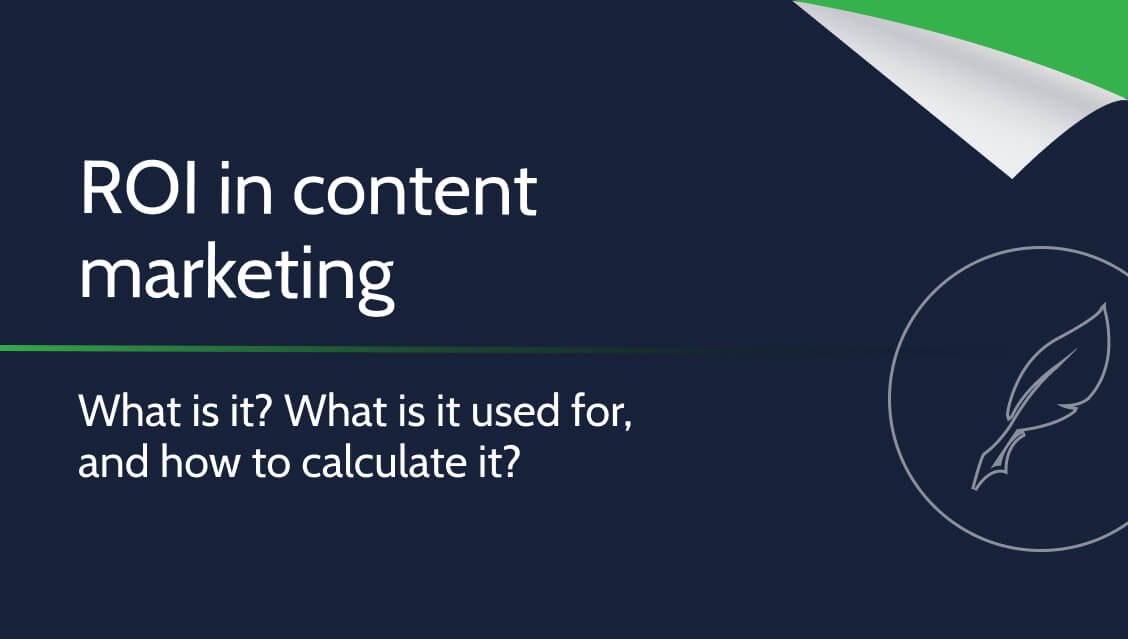ROI in content marketing – what is it and how to calculate it?

One of the finest ways to draw in new clients, boost product or service sales, and enhance the company’s reputation is through content marketing. But how can you gauge its success and determine whether the costs of producing and disseminating content were worthwhile? Calculating the return on investment, or ROI, is one of the finest methods to gauge this. Find out how to do it!
What is ROI in content marketing?
Return on investment (ROI) is an indicator of return on investment, courtesy of which it is possible to measure the rate of return on investment.
The calculation of ROI in content marketing is a technique to see how much money the business has made in relation to the expenses associated with producing and distributing content.This helps you to assess the strategy’s value and efficacy and optimize it going forward for even better outcomes.
In actuality, your actions proved to be more successful the higher the ROI in content marketing. A profitable investment is one in which this indicator is positive, that is, when it rises over 1. But it’s important to keep in mind that content marketing is a long-term plan, so initial results might not be as expected. Be patient as a result!
Why is it important to calculate ROI for content marketing?
In order to determine whether your actions are bringing in the anticipated revenue and whether it is greater than the costs incurred, it is important to first calculate the ROI.
Additionally, an accurate ROI calculation and interpretation will help you better manage your finances and future decisions. When you calculate it, you’ll learn which campaigns are more and which are less profitable, how much traffic each piece of content brings in, and how SEO is impacted. All of this will enable you to develop content marketing initiatives in the future that are more successful.
How to calculate ROI
You must first be familiar with the methodology you’ll use to determine the ROI.
In content marketing, RO: (returns – investment / investment) × 100
Estimating the return is typically the toughest issue. This can be accomplished by looking at all of the connections between your content and sales. Analyze your revenue generation from the material you produce and disseminate, accounting for the website’s conversion rate, the volume of completed transactions, and the resulting revenues.
Additionally, take into account additional measures that will enable you to gauge the success of content marketing and calculate the money you have generated as a result. We are discussing website traffic and user behavior, CTA clicks, the quantity of leads produced as a result of the content, or user engagement on your social network.
In turn, “investment” refers to all expenses associated with producing and disseminating information, whether internal (e.g., employee pay) and external (e.g., labor commissioned from freelancers).
See also
What to do in case of negative ROI
Several factors contribute to the unprofitability of content marketing initiatives. Of course, the low-quality content you share with your potential consumers is the most crucial. Therefore, make sure all your contents are readable, intriguing, and useful to users. Ensure that they are also properly formatted (They need to be broken up into paragraphs and have headings or differentiators, such bold or bullet points) and SEO-optimized (it needs to have relevant keywords, internal and external links, and bullet points).
If you want to improve ROI in content marketing, also make sure that your content:
- are tailored to a specific target group, for instance, in terms of terminology and if they respond to inquiries from potential clients;
- have been supplemented with interesting photos, graphics and video materials, which greatly enhances their caliber and more successfully engage recipients;
- are well distributed – it is important to publish content on other websites and social networks in addition to your website or blog in order for the receivers to see it;
- contain CTAs – i.e., calls to action, which boost conversions and improve the effectiveness of content (e.g., “buy now,” “check,” “learn more,” “call,” “subscribe to the newsletter,” etc.).
Use the services of a skilled copywriters if you want your material to have the desired impact. This person will be concerned with the content’s quality, including the language used to describe benefits and SEO optimization.
Summary
- ROI stands for return on investment, and it allows you to determine the profitability of your content marketing investments.
- If the ROI is positive (if it rises to a value greater than 1 or 100%), a content marketing investment will prove to be lucrative.
- In content marketing, calculating ROI enables future optimization of the measures taken in addition to confirming their efficacy in the present.
- You must ascertain the sum of the costs and revenues produced by content marketing operations in order to calculate ROI.
- A low ROI is a warning that your content needs to be better and that you should think about how it is disseminated.

















Leave a Reply